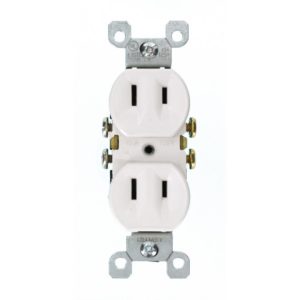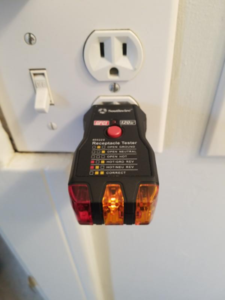Homes built through the 1950s had ungrounded (2-prong) receptacles. That was the norm then but is an inconvenience today.
Chester County Home Inspections often find outlets with Open Ground faults. That occurs when homeowners install 3-prong receptacles in the place of the 2-pronged ones, leaving the grounding conductor open. That is an Open Ground defect as the tester found in this home.

You can replace the 2-prong receptacle with a 3-prong one provided that the branch circuit is protected by GFCI. There are two ways to protect the branch circuit: with a GFCI circuit breaker in the panel to protect the entire branch, or with a GFCI receptacle device to protect a part of the branch. In the latter case, all receptacles in the daisy-chain after the GFCI are protected also (but the ones before are obviously not protected). There is an additional requirement that must be met, though.
All ungrounded outlets protected by a GFCI must be labeled accordingly. If the whole branch is protected by a GFCI circuit breaker in the panel, then each receptacle on the branch must be labeled “GFCI Protected”, and “No Equipment Ground”. If only a part of that a branch is protected by a GFCI receptacle device, then it must be labeled “No Equipment Ground”, and all outlets that come after that must have both labels.
It is tedious to figure out the daisy-chain sequence of receptacles on the branch. Also, there are complexities if the house is wired with shared neutrals, and additional limitations not listed in this short overview. It’s therefore best to leave this job to a professional electrician.
Caveat #1: even when done correctly, the GFCI will still show open ground with a wiring tester. That’s because it remains ungrounded, although safe from shock. It is not a defect if the outlet is marked as ungrounded, but without that label, we must surmise that it is improperly wired. The labels are important.
Caveat #2: watch out for double GFCIs on one branch line, it has ramifications that could drive you nuts trying to find the reason for dead outlets.
Specialty Inspection Services
- Electric systems – We regularly see electric systems that make our hair stand up without touching a thing. Contact us for a shocking investigation.
- Water infiltration – We often see elaborate waterproofing systems in homes when all that was needed was basic landscape management outside. Before you spend big to dig up the basement, let us do a ground-level investigation.
- Restoration assessments – We like the charm of old homes. We also understand their pitfalls. If you have your mindset on an old charmer, contact us for a custom inspection proposal based on the amount of detail you need to uncover.
Conclusion
Ungrounded outlets cannot be fixed without adding ground, but you can have safe 3-prong outlets even when your house is ungrounded. Want to know more? OHSA explains. Need an inspection of your home? Schedule online now, or contact us at (484) 212-1600.
